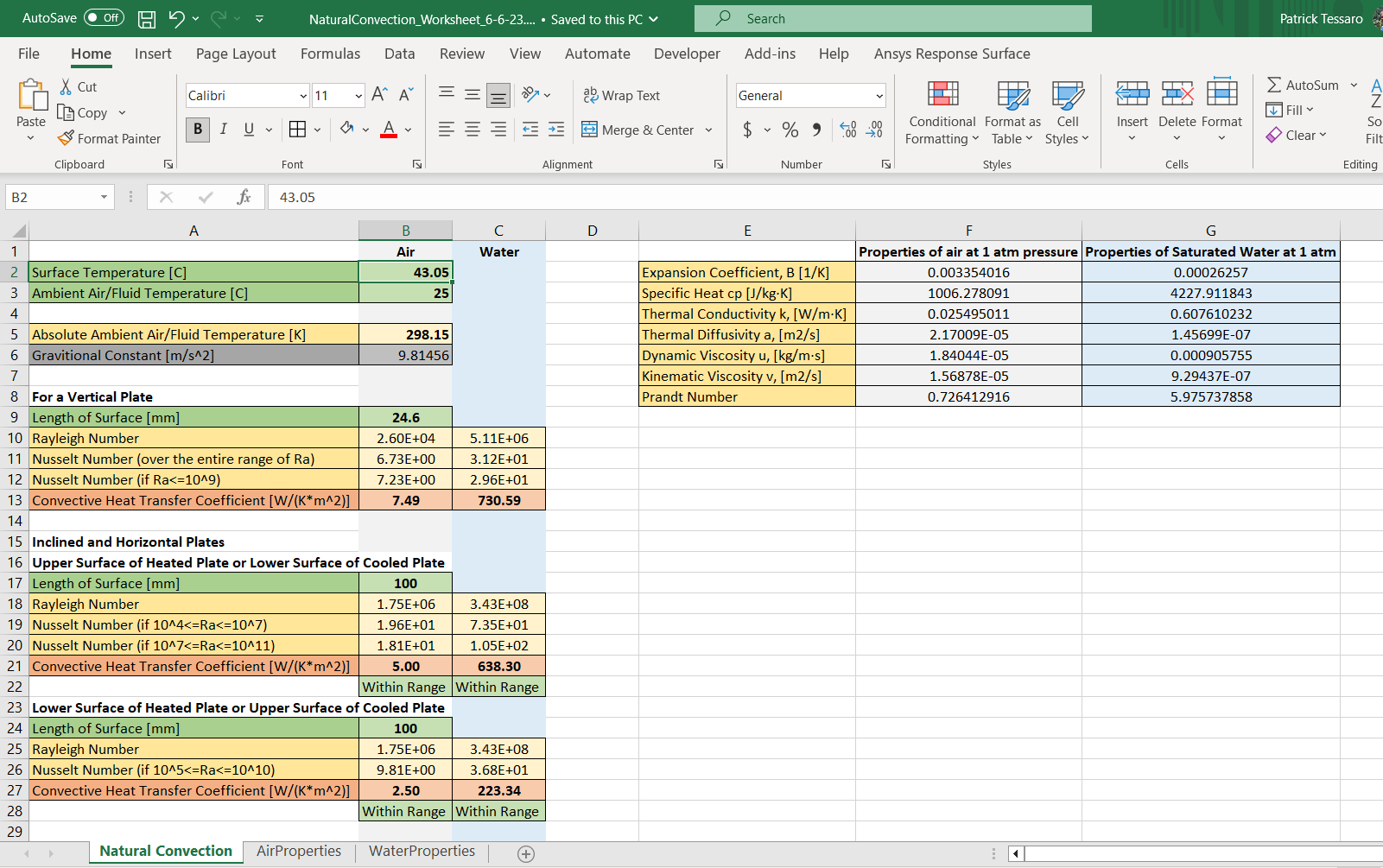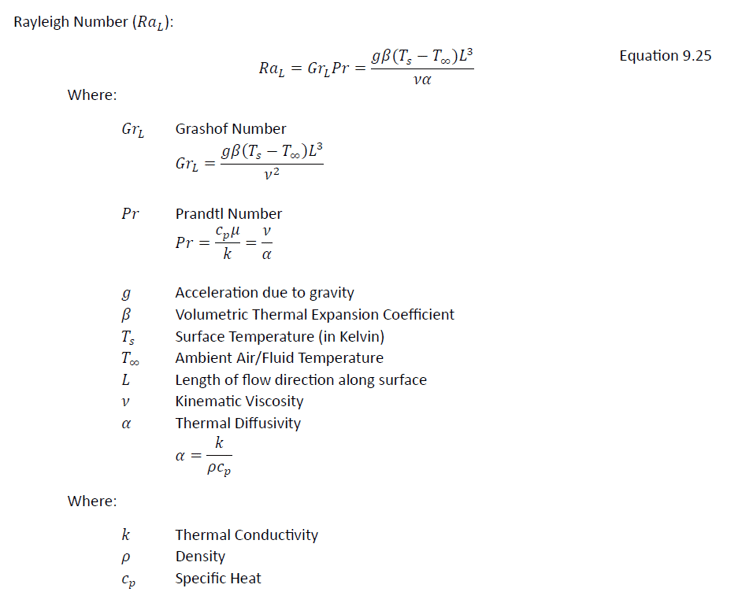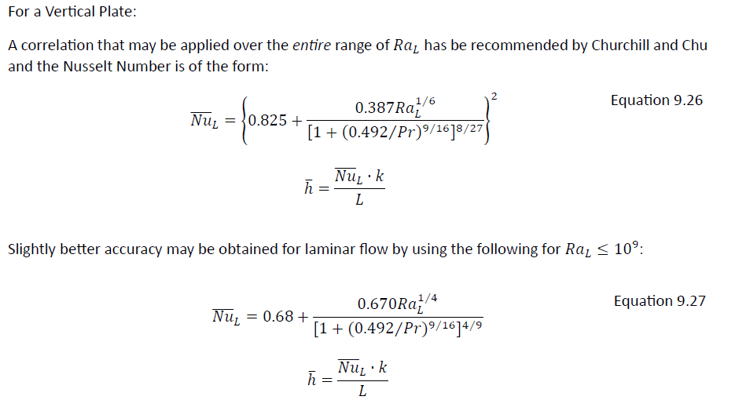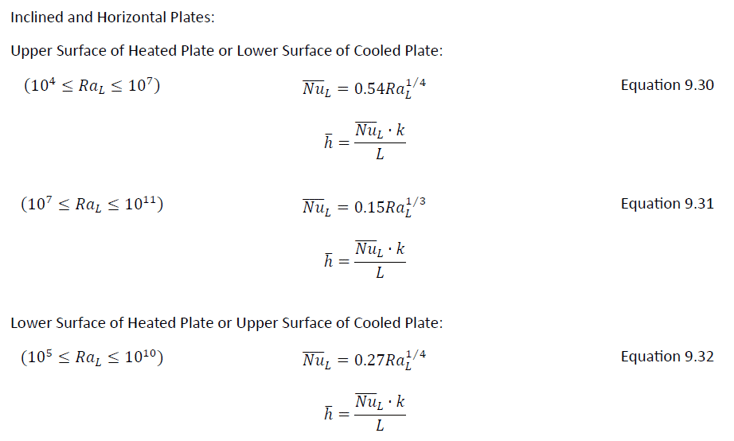Introduction
Convection, in general, can be defined as the process by which heat is transferred by movement of a heated fluid such as air or water.
Natural Convection (a specific variety of convection) can be defined as the movement of a fluid caused by the tendency of hotter and therefore less dense material to rise, and colder, denser material to sink under the influence of gravity, which consequently results in transfer of heat.
The purpose of this document is to demonstrate how to calculate heat transfer coefficients for these surfaces surrounded by either air or by water held at constant ambient temperatures and to discuss the theory associated with a few simple types of natural convection (flow over flat vertical or horizontal plates).
This Excel spreadsheet calculates the convective heat transfer coefficients based on air and water properties at the defined ambient temperatures while using the formulae described below in the Calculation Details. The advantage of this spreadsheet is that it simplifies two complex tasks:
- Providing the properties of air and water at the ambient temperature of interest, and
- Performing the calculation of natural convective heat transfer coefficients under several typical scenarios

How to Operate Excel Natural Convection Worksheet
Download the Excel spreadsheet to your computer and open.
Three tabs are visible: "Natural Convection", "AirProperties" and "WaterProperties". All calculations are performed within the "Natural Convection" worksheet. Input values are entered into the green  "Surface Temperature", "Ambient Air/Fluid Temperature" and "Length of Surface" fields. Results are produced in the orange
"Surface Temperature", "Ambient Air/Fluid Temperature" and "Length of Surface" fields. Results are produced in the orange  fields.
fields.
The air and water properties are calculated based on the "Ambient Air/Fluid Temperature" from a collection of curve fitted formulae based on those tabular data embodied within the "AirProperties" and "WaterProperties" worksheets.
The "Surface Temperature" may not be known at first, but we make a guess to calculate our first convective heat transfer coefficient. We apply this convective heat transfer coefficient to our model and analyze to solve for temperatures and derive the "average" temperature of that same surface. We enter this "new" average temperature in our spreadsheet to calculate a "new" convective heat transfer coefficient and apply that "new" value to our model and analyze and solve for temperatures. We repeat this process until there is little change between the solved average temperature and the temperature we used to estimate our convective heat transfer coefficient. This temperature often converges after 1 to 3 iterations.
Calculations are performed for both "air" (column B) and for "water" (column C), which are presented in columns labeled as such. Obviously the "air" convective heat transfer coefficients are much smaller than those for "water".
The "Length of Surface" is also known as the "Length of flow direction along surface". For a rectangular flat horizontal plate, this will be the smaller of the two dimensions. For example, a plate that is 300mm by 600mm, we would use 300mm as our length, since this is the path of least resistance for our fluid flow. However, if our flat plate is inclined, or vertical, then this distance represents the plate length in the direction of inclination. To be clear, if our 300mm by 600mm plate was inclined such that the long direction was lifted at one end, then our length would be 600mm entered into our calculations. For vertical plates, this length is our plate height.
Calculation Details
The following formulae are sourced from "Introduction to Heat Transfer, Third Edition", (Incropera and DeWitt), "Empirical Correlations: External Free Convection Flows, Chapter 9.6".
The basic premise for these calculations is that there is a temperature difference between the object we would like to analyze and the surrounding ambient fluid (gas or liquid). This temperature difference changes the local density of the fluid near our object, and that fluid begins to move, trading places with fluid molecules having a different density. The rate of this movement depends on the fluid properties and the temperature difference. Ultimately, due to this movement, the transfer of heat moves from the hotter heat source to the colder heat sink. The rate of this convective action is directly related to the heat transfer capacity of the surrounding fluid. For example, if the surrounding fluid is water, then more heat transfer will occur compared to the same temperature condition but surrounded by air.
These formulae are based on a collection of dimensionless numbers, such as the Nusselt Number, Rayleigh Number and Prandtl Number, as well as various properties of our surrounding fluid. The only property used from our object of heat transfer, is the average temperature across the surface for which we will apply our newly calculated convective heat transfer coefficient.



Tags:
Thermal, Mechanical, convection, HVAC, Sherlock, Ansys, Fluent, Power Electronics, buoyancy, Prandtl, Nusselt, Rayleigh, Vertical, Horizontal
Jun 13, 2023 8:07:13 PM
